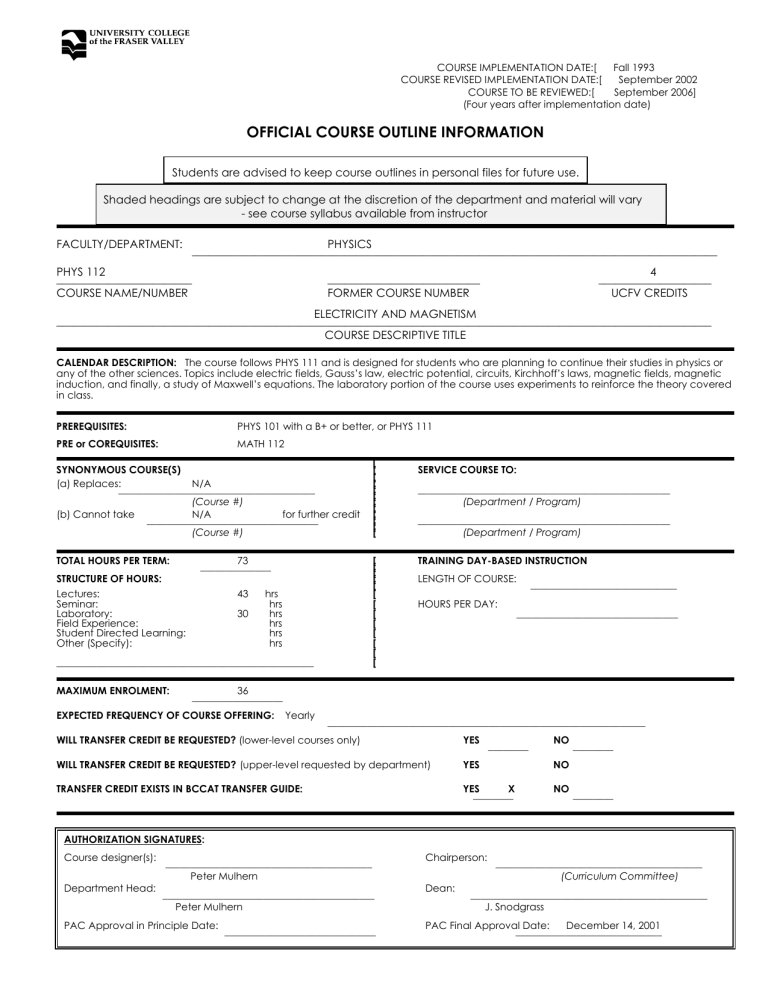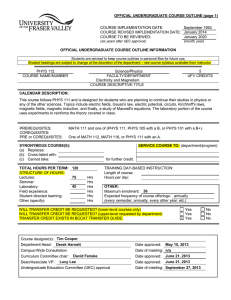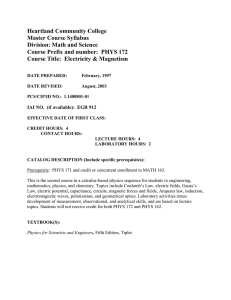official course outline information
advertisement

COURSE IMPLEMENTATION DATE:[ Fall 1993 COURSE REVISED IMPLEMENTATION DATE:[ September 2002 COURSE TO BE REVIEWED:[ September 2006] (Four years after implementation date) OFFICIAL COURSE OUTLINE INFORMATION Students are advised to keep course outlines in personal files for future use. Shaded headings are subject to change at the discretion of the department and material will vary - see course syllabus available from instructor FACULTY/DEPARTMENT: PHYSICS _____________________________________________________________________________________________ PHYS 112 ________________________ COURSE NAME/NUMBER 4 ____________________ UCFV CREDITS ___________________________ FORMER COURSE NUMBER ELECTRICITY AND MAGNETISM ____________________________________________________________________________________________________________________ COURSE DESCRIPTIVE TITLE CALENDAR DESCRIPTION: The course follows PHYS 111 and is designed for students who are planning to continue their studies in physics or any of the other sciences. Topics include electric fields, Gauss’s law, electric potential, circuits, Kirchhoff’s laws, magnetic fields, magnetic induction, and finally, a study of Maxwell’s equations. The laboratory portion of the course uses experiments to reinforce the theory covered in class. PREREQUISITES: PHYS 101 with a B+ or better, or PHYS 111 PRE or COREQUISITES: MATH 112 SYNONYMOUS COURSE(S) (a) Replaces: N/A _______________________________________ (Course #) (b) Cannot take N/A for further credit __________________________________ (Course #) TOTAL HOURS PER TERM: STRUCTURE OF HOURS: 73 ______________ Lectures: Seminar: Laboratory: Field Experience: Student Directed Learning: Other (Specify): 43 30 [ [ [ [ [ [ [ [ [ [ [ [ [ hrs hrs hrs hrs hrs hrs ___________________________________________________ MAXIMUM ENROLMENT: [ [ [ [ [ [ [ [ [ [ [ [ SERVICE COURSE TO: __________________________________________________ (Department / Program) __________________________________________________ (Department / Program) TRAINING DAY-BASED INSTRUCTION LENGTH OF COURSE: HOURS PER DAY: _____________________________ ________________________________ 36 __________________ EXPECTED FREQUENCY OF COURSE OFFERING: Yearly _______________________________________________________________ WILL TRANSFER CREDIT BE REQUESTED? (lower-level courses only) YES WILL TRANSFER CREDIT BE REQUESTED? (upper-level requested by department) YES NO TRANSFER CREDIT EXISTS IN BCCAT TRANSFER GUIDE: YES X ________ NO ________ NO ________ ________ AUTHORIZATION SIGNATURES: Course designer(s): Department Head: _________________________________________ Peter Mulhern __________________________________________ Peter Mulhern PAC Approval in Principle Date: ______________________________ Chairperson: Dean: _________________________________________ (Curriculum Committee) _______________________________________________ J. Snodgrass PAC Final Approval Date: December 14, 2001 _____________________________ Page 2 PHYS 112 __________________________________ COURSE NAME / NUMBER LEARNING OBJECTIVES / GOALS / OUTCOMES/ LEARNING OUTCOMES: Students who enroll in this course have completed Physics 111 and Math 111 (Calculus) or their equivalents. The course is intended for students who are planning to study engineering, science, and life sciences. Students will be able to: 1. 2. 3. 4. 5. understand the fundamental laws of electricity, and magnetism, and learn how to apply the theory to solve related problems apply physics to everyday situations and phenomena in engineering, science, and life sciences use and investigate modern apparatus, perform fundamental laboratory experiments, and interpret data obtained develop a feeling for the order of magnitude of physical quantities in real experiments emphasis will be placed on assigning problems which require the student to use calculus in their solutions METHODS: This course will be presented using lectures and laboratory experiments. Films or other audio-visual aids will be used where appropriate. Problems will be assigned on a regular basis which are to be handed in and marked. Problems that require the use of calculus will be emphasized. Close coordination will be maintained between laboratory and classroom work. Computer-assisted learning programs will be used to increase the understanding of the concepts being studied. PRIOR LEARNING ASSESSMENT RECOGNITION (PLAR): Credit can be awarded for this course through PLAR YES NO X METHODS OF OBTAINING PLAR: If a student can show evidence of skill equivalent to the lab part of the course, we are willing to consider that plus successful completion of a final exam as equivalent to the course. TEXTBOOKS, REFERENCES, MATERIALS: [Textbook selection varies by instructor. An example of texts for this course might be:] Halliday/Resnick/Walker, Fundamentals of Physics, 6th edition extended, John Wiley & Sons, Toronto, 2000 References: F. Beuche, Introduction to Physics for Scientists and Engineers, 3rd ed., McGraw-Hill, 1980 F. Sears & M. Zemansky, University Physics, 5th ed., Addison Wesley, 1979 R. Serway, Physics for Scientists and Engineers, Holt, Rinehart and Winston, 1993 SUPPLIES / MATERIALS: Page 3 PHYS 112 __________________________________ COURSE NAME / NUMBER STUDENT EVALUATION: [An example of student evaluation for this course might be:] Assignments Midterm Laboratory work Final exam 20% 25% 15% 40% COURSE CONTENT: [Course content varies by instructor. An example of course content might be:] 1. 2. 3. 4. 5. 6. 7. Coulomb’s Law, electric field, potential, capacitance, Gauss’ Law electric current, electromotive force, Ohm’s Law, Joule’s Law, Kirchhoff’s Laws, RC time constant magnetic field, currents, force on a moving charge sources of magnetic field, Ampere’s Law, production of B fields, B of long straight wire magnetic induction, induction, induced emf, Faraday’s Law, Lenz’s Law, mutual inductance, energy in a magnetic field Maxwell’s Equations, E and B waves, energy in E/m waves introduction to time varying electric and magnetic fields



